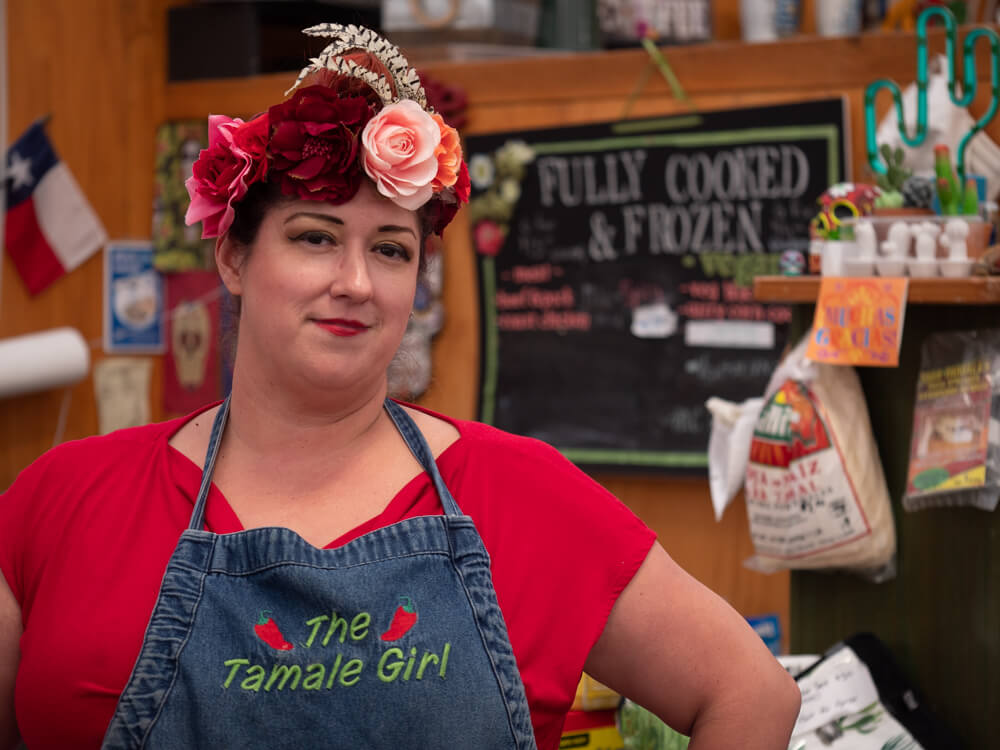The air carries a hint of spice.
Colourful soda bottles line the narrow front counter where customers wait patiently. A stove and crockpot work non-stop at the back, next to a wall decorated with the swirling skulls of the Day of the Dead.
Six steps from end to end, in this little booth at the St. Jacob’s Market, a big dream is taking shape.
That dream is Kathy Hanshaw’s — “The Tamale Girl.”
“There is a lot of tradition involved here,” said the 47-year-old entrepreneur, wearing a crown of flowers and a blue apron emblazoned with peppers.
Tamales date back thousands of years to the time of the Aztecs, and Hanshaw makes them much the same way as back then: Meat or vegetables are spread over a corn flour mixture, called Masa. They are then wrapped, steamed and served in a corn husk that keeps the tamale together.
The result is a healthy, Central American delicacy, which Hanshaw first encountered at her childhood dinner table. She grew up in Corpus Christi, Texas, where her grandmothers would serve them during the Christmas holidays.
“Tamales were just part of life. We were poor, and the things they could make with what we had were very creative,” Hanshaw said.

She also credits her mother, who had Mexican heritage, for imparting a life-long love of cooking.
“My inspiration always came from their ability to make something amazing with so little.”
Turning tamales into a business came much later.
Hanshaw tried culinary school in her 20s, but that didn’t pan out.
A few years later, she started a family while “floating” around to different retail and service jobs. She carried a love for cooking with her, but her plate was full without a small business to run on the side.
It wasn’t until December 2010, when she brought a chafing dish of tamales to a potluck at work, that she saw a vision of what “The Tamale Girl” could be — and how she could make it happen.
“Within two weeks, I had orders for, I’d say, 250 dozen,” she said. “That’s when I decided to get serious.”
While living in Oshawa, she built up a customer base between her role as a stay-at-home mom and a part-time worker in the service industry.
Her first big success was getting a local grocer to stock her tamales. After that, Hanshaw branched out to festivals, attending events in places like Kingston, Belleville and Orillia.
She would often pack her equipment (and sometimes her young daughter, Cleo, who would help out) into a car and head off for a day of tamale-selling. And when she wasn’t working, commuting or raising a kid, Hanshaw was making her tamales by hand in a commercial kitchen space she would rent out from friends in the restaurant industry.
She called it all a “crockpot start”: the ingredients for a successful business were there – customers, a product, a plan – they just needed time to simmer.
“I thought between festivals, catering and the grocer it would be a living, but it so wasn’t at the time,” she said.
Reflecting on where she is now, Hanshaw said it was not a straight line, but more like a “jagged rollercoaster.” And at her lowest point, she thought about getting off the ride.
In 2017, Hanshaw had signed up for a vegetarian food festival. But after paying the venue fee and putting in a hard day’s work, she came back with little to show for it.
“Didn’t make a penny,” she said. “I was down and out.”
It was like the universe was telling her to quit:
On top of an unsuccessful event, she had applied for a space at the St. Jacob’s Market, but wasn’t hearing back. She was also offered a full-time job at Tim Hortons, which could provide more stability in her life and an escape hatch from the stresses of the small business world.
Hanshaw went so far as to put her tamale pots and other equipment for sale on Kijiji.
The ad was up for one week before she got “the call.”
St. Jacob’s Market had offered her a booth.
“Maybe smart people would have given up … but I knew I had something special,” she said.
After almost two years at the market, she says she is still in the “feeling it out phase,” but business has grown enough that she no longer has to work part-time on the side.
Those extra hours are now spent making up to 500 tamales per week, sometimes more during the summer tourist season.
At her stall, she sells her tamales for $5 each, or $10 for a plate that includes rice and beans and side of homemade salsa. A bulk of her business is also done by selling them frozen, for re-heating.
“The healthy aspect is a huge, huge selling point,” Hanshaw said. Her tamales are lactose, gluten and dairy-free, with vegan options.
She has also been putting her own spin on flavours, like spooky pumpkin spice and coconut corn curry, to go alongside classics like spicy black bean.
“Many I make wouldn’t be considered traditional, but the beauty of tamales is that you are only limited by your imagination.”
She has even hired an employee, Samantha Langros.
“Perky, happy, easy to talk to,” is how Langros, 20, described Hanshaw. It might explain why some customers keep coming back.
“You want to be as excited as you were when you first opened up,” said Hanshaw. “People take for granted when things are going well. One day to the next can be very different.
“Anyone who comes to you twice — that’s a blessing.”

